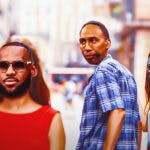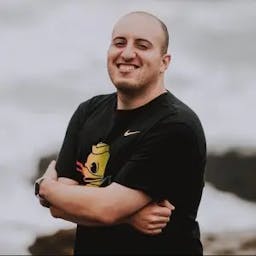Episodes 5 and 6 of “The Last Dance” delved into plenty of subjects, exploring a wide gamut of Michael Jordan antics, his relationships with fellow players, and his ultimate desire to become the best player alive.
Here are six of the best things that took place in these episodes of “The Last Dance.”
Kobe on Michael
Episode 5 of “The Last Dance” opens with Jordan's relationship with Kobe Bryant after the two shared the court during the 1998 All-Star Game. Jordan had noticed Bryant was relishing the opportunity to go one-on-one against others and was determined to put a stop to it in front of a sold-out Madison Square Garden crowd.

Naturally, Jordan gave Bryant the business end of a schooling on his way to a third All-Star MVP award, but not before Bryant took notes and asked questions that Jordan was completely willing to answer:
“I grew up watching Michael on TV,” said Bryant. “Now you got a chance to go face-to-face with him. A chance to touch and feel strength, speed, quickness. It was fun to be out there.
“It was a rough couple of years for me coming into the league because at the time the league was so much older, it wasn’t as young as it is today. Nobody was thinking much of me, I was just a kid who shot a bunch of air balls. At that point Michael provided a lot of guidance for me.”
Not only did Bryant have the ultimate respect for Jordan, but he also attributed a lot of his success to Jordan's willingness to teach him the ropes:
“What you get from me is from him,” said Bryant. “I don’t get five championships here without him, because he guided me so much and gave me so much great advice.”
Jordan's influence on Kobe was evident whenever the Lakers legend suited up, and in “The Last Dance” we get it right from the horse's mouth.
Michael Jordan: The Brand
Surprisingly, a young Michael Jordan didn't choose Nike from the onset as his choice of footwear. He instead wanted to wear Adidas, a brand he had grown fond of during his three years in college.
At the time, Converse was the leading brand in the NBA, as the “Weapon” signature line was sported by some of the greats like Larry Bird and Magic Johnson. Nike was merely a track shoe brand, but agent David Falk insisted Jordan listen to their pitch once he lined up a meeting.
Jordan was not keen on it at the time, but the up-and-coming brand was willing to offer $250,000 to net him as the face of their brand. At the time, even the best stars were only getting $100,00 for a shoe contract.
Nike was hoping to sell $3 million worth of Jordan sneakers by the end of his fourth year in the league, but they soon realized they had a gold mine in their hands after selling $126 million by the end of his rookie year:
“Nike’s expectation when we signed the deal was at the end of year 4 they hoped to sell $3 million worth of Air Jordans. In year one we sold $126M.”
David Falk pic.twitter.com/LGTOdxxoXx— ClutchPoints (@ClutchPointsApp) May 4, 2020
That also spanned to how he handled business later on during the 1992 Barcelona Olympics, as sponsor Reebok wanted to see The Dream Team don its logo during the gold-medal ceremony, including Jordan.
Jordan was furious about this and even admitted so during a car interview with a reporter sitting in the back seat. Here is their quick exchange, as “The Last Dance” documented:
Jordan: “Harvey Schiller, what a d*ck.”
Reporter: “Who is that?”
Jordan: “The guy who said if we don’t wear our uniforms we can’t accept our gold medal and all that stuff.”
Reporter: “Is that still a big issue, they’re still talking about that?”
Jordan: “Nah, they said they are going to try to hide the Reebok [logo] on it, but they can't hide it like I am going to hide it.”
Jordan would memorably go on to wear a flag over the right side of his body, completely overshadowing the Reebok logo.
Survivor: Toni Kukoc
Stories about Toni Kukoc's initial “welcome to the league” moment have been aplenty, as the Croatian international was held to four points in a game during the 1992 Barcelona Olympics, playing against a motivated Michael Jordan and a furious Scottie Pippen.
Pippen was irate at Bulls general manager Jerry Krause for salivating over Kukoc while also setting aside money for him to come over from Europe, which played a role in Pippen's contract negotiations. Pippen was determined to give Kukoc the works to show up Krause.

The Dream Team would go on to crush Croatia by 33 points in the group stage, as Jordan led all scorers with 21 points, only to meet again in the gold-medal game and beat them by 32. Kukoc played much better in that second contest, scoring 16 points and adding five rebounds and nine assists.
Many gave Kukoc credit for coming back after being “totally emasculated” in the first game, but Michael Wilbon, who covered the Olympics for The Washington Post at the time, noted in “The Last Dance” the Croatian was made of much sterner stuff than he was given credit for:
“Americans didn’t understand how tough people like Toni Kukoc were,” said Wilbon. “They had no idea, no idea about the war-torn situations, and the poverty, and the oppression, that guys like Kukoc came from, that produced them, that hardened them.”
Kukoc would eventually be embraced by Jordan and Pippen and became a key cog on the Bulls after the latter took him under his wing.
“The Jordan Rules” controversy
“The Jordan Rules,” a book by longtime beat writer and columnist Sam Smith, hit the market at a time when Jordan fandom was at its cusp. The book peeled back the curtain on Jordan's often-combative relationship with his teammates and offered a look beyond the image of role model so many had taken after.
Jordan wasn't okay with a lot of the stuff that came out in that book. He still blames former teammate Horace Grant for whistleblowing a lot of things from practices:
“I didn’t contribute to that, that was Horace,” said Jordan.
Grant denies in “The Last Dance” being the one bringing up Jordan's antics in practice:
“That didn’t come from me,” said Grant. “Not one thing have I ever divulged to Sam Smith.”
Ultimately, the book allowed readers to know Jordan as a more human version of the godly persona he had taken during his years of success. He's a flawed individual who made mistakes just like everyone else.
While he faced criticism for some of things exposed in the books, it humanized him and lent another scope to who Jordan was as a ruthless competitor.
Here comes a new challenger: The New York Knicks
The Knicks were quick to take over as the Bulls' new rival after the Detroit Pistons of the late '80s got too old to compete against a younger league. Patrick Ewing, John Starks, and the rest of that Knicks team were determined to knock down the Bulls, facing off during the 1993 Eastern Conference Finals after taking Chicago to seven games in the second round of the playoffs in 1992.

Top-seeded New York took a quick 2-0 lead over the Bulls, at which point Jordan faced plenty of criticism for his decision to go to Atlantic City with his father and gamble at a casino:
“My father said, ‘Let’s get away from New York City. Let’s you and I go to Atlantic City,’” said Jordan back then. “We got a limo and went and gambled for a couple of hours and came back. Everybody went totally ballistic – ‘He was in the casino last night.’ It wasn’t late. We got home by 12:30, one o’clock.”
The constant hoopla surrounding Jordan and his gambling habits caused him to give the media the cold shoulder for two weeks before resuming his rapport with them as usual during the 1993 NBA Finals. Jordan and the Bulls wound up winning the next four games against the Knicks to reach those Finals. As shown in “The Last Dance,” Jordan ultimately gave an interview in dark sunglasses to Ahmad Rashad denying his gambling was a problem.
To this day, Jordan maintains he didn't do anything wrong back then:
“I’m actually playing golf with people all the time… and if they want to gamble, we gamble,” Jordan said. “The character of those individuals, I found out later what kind of people I was playing with. I learned that lesson. But the act of gambling? I didn’t do anything wrong…
“I never bet on games; I only bet on myself and that was golf… I told [the NBA league office] exactly what was happening,”
Asked if he had a gambling problem, Jordan had the perfect answer:
“I don't have a gambling problem, I have a competition problem.”
An iconic line from an iconic player.
Jordan vs. Barkley
The 1993 NBA Finals was a battle of titans between Michael Jordan and Charles Barkley. Jordan was admittedly miffed Barkley was awarded the 1993 NBA MVP award, determined to walk away with the ultimate bragging rights:
“Okay, you can have that, but I’m gonna get this,” said Jordan, pointing to the Larry O'Brien Trophy.
The Bulls won Game 1, but Barkley was determined to even it out in Game 2. Barkley argued he played one of the best games of his career (42 points, 13 rebounds) in that Game 2, only he was still one-upped by Jordan (42 points, 12 rebounds, nine assists) in a 111-108 loss:
“That was the first time in my life that I felt like there was a better basketball player than me,” said Barkley.
The Suns won Game 3 in triple overtime, but the Bulls came back to win Game 4 behind 55 points from Jordan, putting the Suns on the brink of elimination. Barkley and company would respond to win Game 5, despite 41 points by Jordan.

Before heading back to Phoenix for Game 6, Jordan addressed his teammates in a closed meeting:
“I’m only packing one suit, I’m not going there to play two games,” Jordan told the team.
The Bulls would go on to win Game 6 and their third straight title before Jordan's first retirement. Barkley has no qualms about losing to Jordan, giving perhaps the most colorful quote at the end of Episode 6:
“Sports are like a gunfight and we lost to the fastest gun.”
Quintessential Chuck, and a great way to wrap up this episode of “The Last Dance.”




